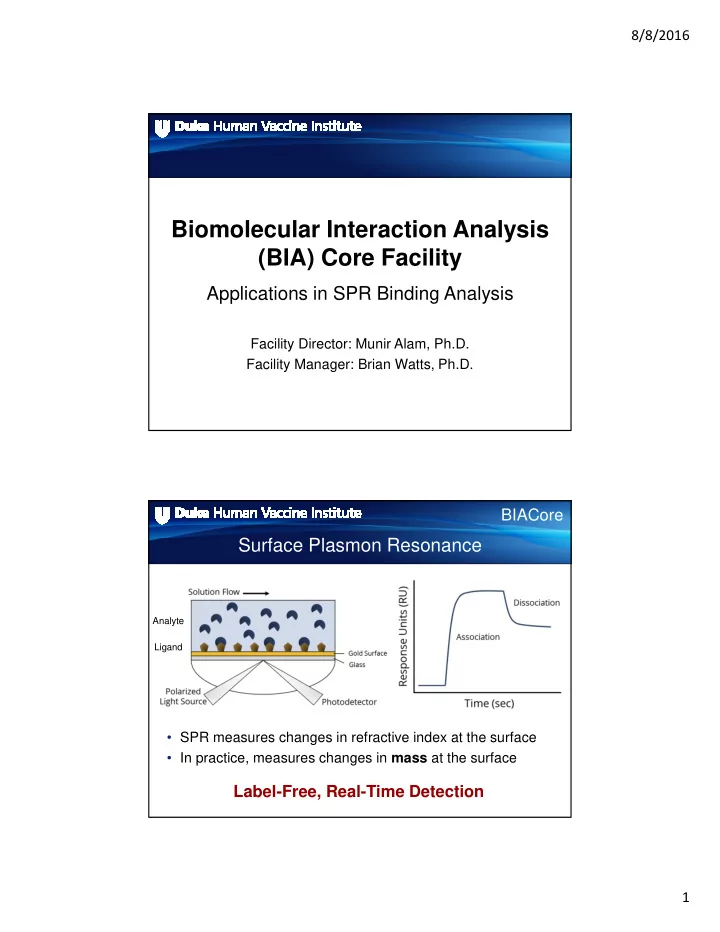

8/8/2016 Biomolecular Interaction Analysis (BIA) Core Facility Applications in SPR Binding Analysis Facility Director: Munir Alam, Ph.D. Facility Manager: Brian Watts, Ph.D. BIACore Surface Plasmon Resonance Analyte Ligand • SPR measures changes in refractive index at the surface • In practice, measures changes in mass at the surface Label-Free, Real-Time Detection 1
8/8/2016 BIACore Surface Plasmon Resonance k off K D = k on BIACore Biomolecular Systems • Can measure protein interactions with • Proteins and peptides • DNA and RNA • Small molecules • Lipid membranes, micelles, and vesicles • Carbohydrates PDB: 1CJ1 • Synthetic polymers • Viruses • Whole cells • Samples can be purified or complex • For affinity/kinetics – SEC purified (>95%) • Cell culture medium • Clinical sera or bodily fluids 2
8/8/2016 5 BIACore Experimental Considerations 1. Immobilization • How to functionalize a binding partner to the sensor chip? 2. Binding • What type of assay/design? 3. Regeneration • How to remove bound analyte without damaging ligand? 6 BIACore SPR Sensor Chips • Carboxymethylated Dextran • Biocompatible and Robust • Low non-specific binding CM-Dextran • Available in varying dextran lengths Gold and CM density Glass • CM3, CM4, CM5 , CM7 • C1 – Carboxylated gold (no dextran) • Direct Immobilization • Reactive carboxyl handle • Amine Coupling – EDC/NHS • Thiol Coupling – Disulfide • Thiol Coupling – Maleimide • Aldehyde Coupling CM Dextran C1 3
8/8/2016 7 BIACore SPR Sensor Chips • High-Affinity Ligand Capture • Modify CM dextran w/ capture molecule • Streptavidin-Biotin (SA chip) • α -F c or Protein A (Prot A chip) • α -His or NTA (NTA chip) • α -GST • α -FLAG • Applicable to any high affinity tag • Hydrophobic Adsorption • Sensor Chip HPA – Alkanethiol gold • Lipid bilayers or monolayers • Sensor Chip L1 - Lipophilic residues on CM5 • Captured vesicles or micelles 8 BIACore Direct vs. Capture Direct Immobilization Binding Immob. Regeneration Ligand Capture Capture Immob. Binding Regeneration 4
8/8/2016 9 BIACore Direct vs. Capture • Direct Immobilization • Simple and Robust • Immob. level less flexible • Requires less ligand • Requires regeneration scouting • Ligand Capture • More complex design • Can fine-tune ligand immob. level • Takes advantage of affinity tags • Regen. conditions may be known • Each cycle requires fresh ligand 10 BIACore Regeneration • Injection of a buffer designed to disrupt bound complex • Often a trial and error process to identify ideal conditions • Acidic : 10 mM Glycine-HCl (pH 1.5-3.0) • Basic : 1-100 mM NaOH • Ionic : 4 M MgCl 2 , 5 M NaCl • Chaotropic : 2 M Guanidine-HCl, 1 M Urea • Detergent : ≤ 0.5% SDS, ≤ 0.5% Tween 20 • Chelating : 20 mM EDTA 5
8/8/2016 11 BIACore Regeneration • Regeneration too weak • Incomplete analyte removal • Increasing baseline • Reduced binding response • Regeneration too strong • Complete analyte removal • Loss of ligand activity • Reduced binding capacity 12 BIACore Experimental Considerations 1. Immobilization • Direct Immobilization vs. High Affinity Capture • Immobilization level • Low (Kinetics) vs. High (Screening or LMW Affinity) 2. Binding • Desired experimental outcome • Assay design • Protein purity and concentration • Protein quantity (~100 µg) 3. Regeneration • Mildest conditions necessary • Complex and surface ligand stability 6
8/8/2016 BIACore SPR Experiments • Specificity and Screening • Yes/No Binding • Ranking of binding response • Kinetics and Affinity • Multi-cycle or single-cycle • Direct binding • Steady-State Affinity • Solution-based Affinity • Concentration k off K D = • Surface Competition k on • Solution Inhibition • Epitope Mapping • Conformational Changes • Thermodynamics BIACore BIA Core Facility Biacore 3000 Biacore 4000 Biacore T200 ForteBio Biacore S200 Octet-RED96 gehealthcare.com/biacore, fortebio.com 7
8/8/2016 BIACore BIA Core Facility Biacore 3000 • Two (2) 3000s available • Four (4) serial flow cells • Simultaneous detection of up to 4 interactions per injection cycle µ-fluidic cartridge Serial Flow Cells • Autosampler • Senstivity down to 10 RU gehealthcare.com/biacore BIACore BIA Core Facility Biacore 4000 • Four (4) independent flow cells each equipped with 5 detection spots • Simultaneous detection of up to 16 interactions per injection cycle • Autosampler supports 96- and 384-well plates in 10-plate Independent Flow Cells hotel with detection spots • Designed for high-throughput analyses • Approved for clinically derived and/or infectious samples gehealthcare.com/biacore 8
8/8/2016 BIACore BIA Core Facility Biacore T200 • Four (4) serial flow cells • Simultaneous detection of up to 4 interactions per injection cycle • Autosampler supports 96- and 384-well plates • Integrated degasser • Sensitivity down to 1 RU allows detection of small molecule analytes gehealthcare.com/biacore BIACore BIA Core Facility Biacore S200 • Four (4) serial flow cells • Autosampler supports 96- and 384-well plates • Integrated degasser • Increased sensitivity below 1 RU allows for improved detection of small molecule analytes • Specifically designed for high throughput screening of LMW analytes gehealthcare.com/biacore 9
8/8/2016 BIACore BIA Core Facility ForteBio Octet-RED96 • Biolayer Interferometry (BLI) • Generates similar results as SPR • Ligand-coated biosensor tips submerged in a 96-well plate • Parallel processing of up to 96 interactions • No need for regeneration • Crude sample compatibility fortebio.com BIACore BIA Core Facility How to Utilize the BIA Core • Sample Submission • Available for the 3000, 4000, S200, and BLI • Trained technicians will optimize experiments and complete data analysis. • Independent Use • Available for the T200 • Specialized training and support • Reserve T200 through CoreResearch@Duke • Available to researchers 24/7 gehealthcare.com/biacore 10
Recommend
More recommend